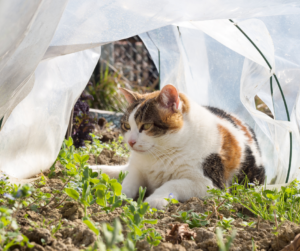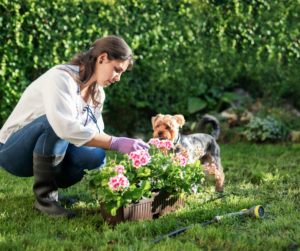Gardening Tips for Pet Parents: Pet-Friendly Plants and Pesticide Safety

By Carol Bryant, Professional Pet Blogger
At least 80 percent of U.S. households participated in lawn and gardening activities in 2022 —are you among them? For pet parents who love to garden, this means getting closer to nature while ensuring the safety of their dogs and cats. Choosing the right plants is essential to creating the garden of your dreams. However, making the right choices about mulch, dirt, plants, and pesticides is essential without posing risks to your pets. For example, strategically placing tick tubes in your yard every spring and then again mid-season, your pets and family are at less risk of a tick bite in your yard and surrounding area. In this guide, we’ll share gardening tips for pet parents so you can cultivate a space that looks good and is safe for pets.
Creating a Pet-Friendly Garden
Choosing the right plants or vegetables is fundamental to a pet-friendly garden. Using herbs like mint, thyme, or basil makes for tasty additions to your recipes but is also non-toxic to pets. Consider pet-safe vegetables like carrots and zucchini if your dogs or cats steal a stay bite or two. Another common danger lurking in gardens is mulch. Not only is mulch prone to fungal growth if consistently damp, but some mulch is dangerous to pets. Cocoa mulch looks good and is very aromatic, but cocoa shells contain theobromine and caffeine, which are toxic if ingested in specific quantities. Pet parents may prefer pet-safe alternatives to mulch, such as cedar or shredded pine. While pets should not eat any garden substance, these mulches are less likely to cause significant issues. Designating certain garden areas as off-limits to your pets will save a lot of frustration. If your garden has fencing, consider installing a gate and keep it closed when you aren’t around. Ensure any fencing is tall enough and narrow so that dogs or cats can’t escape. Supervise your pets when they are outside near the garden. If your yard is fenced-in, consider installing an outdoor camera to closely monitor your dogs and cats.
zucchini if your dogs or cats steal a stay bite or two. Another common danger lurking in gardens is mulch. Not only is mulch prone to fungal growth if consistently damp, but some mulch is dangerous to pets. Cocoa mulch looks good and is very aromatic, but cocoa shells contain theobromine and caffeine, which are toxic if ingested in specific quantities. Pet parents may prefer pet-safe alternatives to mulch, such as cedar or shredded pine. While pets should not eat any garden substance, these mulches are less likely to cause significant issues. Designating certain garden areas as off-limits to your pets will save a lot of frustration. If your garden has fencing, consider installing a gate and keep it closed when you aren’t around. Ensure any fencing is tall enough and narrow so that dogs or cats can’t escape. Supervise your pets when they are outside near the garden. If your yard is fenced-in, consider installing an outdoor camera to closely monitor your dogs and cats.
Top 10 Dangerous Plants to Pets
Every day, the Pet Poison Helpline (PPH) receives dozens of calls from pet parents who say their pets ate a plant or flower. According to PPH, “While there are thousands of species of plants and flowers, only a small percentage of plants are truly dangerous and poisonous to your pet.” PPH reports these as the top 10 plants that are poisonous to pets:
- Autumn Crocus
- Azalea
- Cyclamen
- Kalanchoe
- Lilies
- Oleander
- Lily of the Valley
- Sago Palm
- Tulips
- Hyacinths
Learn more about other poisonous plants to pets on the Pet Poison Helpline website.
Pesticide Safety in Pet-Friendly Gardens
Properly using and storing pet-friendly pesticides and insecticides is essential. Always read the label of any product you plan to use in your garden. After applying the products, keep your dogs and cats away from the garden for a specific period, usually found on the label. During a pet-friendly vacation to Maine a few years ago, my spouse and I sought emergency care for our Cocker Spaniel. After playing on the lawn at the bed and breakfast where we stayed, our dog began vomiting and developed a rash on her stomach. Sadly, the owner never informed us that a lawn treatment was applied a few hours earlier. Brandy wound up at an emergency veterinarian on intravenous fluids, the victim of chemical exposure through her paws. She had a bath, a blood panel, and ointment for chemical burns, and we cut our vacation short. I’ve since learned to ask about lawn and garden treatments whenever we travel. Traditional chemicals and garden treatments can cause problems. Consider pet-friendly weed killers if you allow your dog or cat to roam near your garden.
Create a Pet-Proof Garden Space
You want your garden to be fruitful while keeping your pets safe. The best way to do that is with some simple pet-proofing hacks.
- Plant herbs with a pungent odor, like sage and rosemary, to keep cats away.
- For digging dogs, create a nearby play area. Dig a shallow hole, fill it with sand, and add toys for your dog to stay busy.
- Use cedar chips that pets can’t access around the garden to prevent fleas from invading.
- Avoid planting anything with thorns so curious pets avoid injury.
- Use raised beds or sturdy planters out of your pets’ reach.
- Place faux turf in shady areas with a raised cot to encourage your pets to stay in those designated areas away from the garden.
- Avoid planting in straight lines, as dogs tend to run and play along linear barriers.
- Check your pets’ paws after any outdoor time, including near your garden. I like to keep paw wipes at the door so we don’t track any mud or dirt inside. When it’s bath time, I love the ZYMOX Advanced Enzymatic Shampoo and Conditioner, which gently moisturizes and hydrates as it cleans my dog’s skin and coat.
For more about pet-friendly gardening, read about Hidden Pet Toxins and Hazards in Backyards and Beyond. Happy gardening!
About the Author

Gayle King introduced Carol Bryant as a “dog lover of the highest order” when she and her Cocker Spaniel, Dexter, appeared on Oprah Radio. Carol is well-known in the pet industry, having appeared on television, radio shows, and podcasts, as well as in articles from CNN and Yahoo to Dogster and Today.com. She is the founder of the award-winning blog FidoseofReality.com and is the Immediate Past President of the Dog Writers Association of America.

